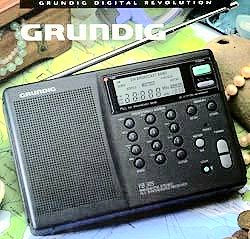

Year Introduced: 1995
Power: Battery, AC adaptor optional
Size: 180 x 120 x 37 mm
Weight: 708g
Price: US$130, CAN$150, £80
Coverage: MW, FM and SW (continuous up to 21850 kHz)
Value Rating star: 



This review was compiled independently. The Medium Wave Circle and Radio Netherlands has no financial connection with R.L. Drake, the manufacturer of this receiver.
After a quiet period the receiver market is starting to move again, prompted by a new travel portable from Grundig. 1995 saw this German consumer electronics company celebrating its 50th year of existance. They have also diversified production outside Europe. The shortwave receiver line has been moved to Grundig North America based in California who in turn have decided to manufacture the Yacht Boy range in the Far East.
In Europe and North America, the Grundig Yacht Boy 305 is an entry-level portable set designed for the travelling market, but its significantly cheaper than the Yacht Boy 400 which was launched in late 1994. The Yacht Boy 305 is a different design inside, being single rather than double conversion, there’s no single-sideband and the tuning steps are coarser than on the more expensive 400. But its not bad value at all.
The first thing that strikes you as you unpack the receiver is that it operates on 3 volts DC rather than 6, and it uses the Size C cells or UM2’s, the next size up from the penlights. An AC power supply is available as an optional extra. In practice though we got around 28 hours of use from a fresh set of alkaline cells. Once you put them in the back, unclip the stand, and the set sits at an angle on the table ready for use. Let’s switch it on. And the liquid crystal display shows the last frequency you were tuned to… in this case 6165 kHz. If you have a new shortwave frequency you want to try you just press the enter button, tap in let’s say 9895 and press enter again.
The Yacht Boy 305 has 10 memory channels for mediumwave, 10 for FM stereo, and 10 for favorite shortwave channels. Unlike, the more expensive Yacht Boy 400, the 305 doesn’t offer longwave, at least on the model we tested. A table on the back of the set reminds you the ranges of the shortwave broadcast bands, although it is possible to tune continuously from 2300 up to 21850 kHz.
The Yacht Boy 305 tunes in 5 kHz steps on shortwave. There are two tiny switches in the battery compartment which let you select 50 or 100 kHz tuning steps on FM, and 9 or 10 kHz tuning steps on mediumwave. The instruction manual explains how to select the right steps depending on where the world you happen to be. The 5 kHz tuning step is coarser than on more expensive portables. You cannot slightly off tune to escape some interference. However we did notice that the single bandwidth filter is remarkably sharp for a set of this nature and strong signals 5 kHz away are well attenuated. A fine tuning control would still have been nice, but this 5 kHz tuning is the best seen in a long time.
The set can help you find the bottom end of the popular shortwave tuning bands such as 120, 60 or 31 metres to take a few examples. The keypad is simple to operate and the keys are well spaced out. It is pretty simple to scan the dial for strong signals and store them in the memory.
The Yacht Boy 305 has no dial light, but it does have a small recessed locking switch to prevent it accidentally springing to life in a suitcase. You can also set the radio to send you to sleep over a period of up to 90 minutes. There’s a two step attenuator on the side of the set. We found that in Europe after dark it was a good idea to switch the setting to local and collapse the telescopic whip antenna. In more remote parts of the world you’ll probably find that you can make do with the built-in antenna. There’s a small socket to connect an external antenna, but the single conversion design of the 305 is sensitive to signal overload. If you realise that too much signal can be as bad as too little then a bit of experimentation will yield the best results with this set.
In short, there have been cheaper PLL synthesized sets on the market before now. But their performance has been mediocre to say the least. The Yacht Boy 305 from Grundig retails in North America at US$129.95, which is about 60 dollars cheaper than the Yacht Boy 400. In Britain we found it in the shops for 79 pounds 95 pence. At that price it is one of the best entry level portables every made. Although made in China, the craftsmanship is fine, and the use of the slightly larger batteries makes for optimum use during travel. You don’t really need the charger with you. We found rechargeable batteries needed to be very fresh in order to get proper performance on the radio, otherwise the battery voltage is too low and you lose sensitivity. The receiver has no clock, again a feature that was left out in order the meet the price range. The English language manual does mention further sources of information but not really enough about the broadcasting stations you can hear on this type of set. Bearing in mind the traveling market includes a lot of impulse buying, information neatly packaged for the newcomer is important and in this case we feel insufficient. But overall a useful new package.
This review first appeared on the Radio Netherlands website.